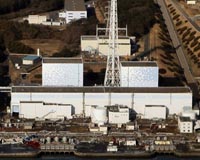| . |  |
. |
Tokyo (AFP) March 16, 2011 A fire which broke out early Wednesday at a quake-hit Japanese nuclear power plant is under control, the government said. "We have received information from TEPCO that the fire and smoke is now invisible and it appears to have gone out of its own accord," Minoru Ogoda, a spokesman for the state nuclear safety agency, told AFP. The plant is operated by the Tokyo Electric Power Co (TEPCO). The blaze had broken out on the fourth floor of the number-four reactor at the Fukushima No. I plant, 250 kilometres (155 miles) northeast of Tokyo. A fire and explosion hit the same reactor on Tuesday, causing a crack in the roof.
earlier related report The blaze at the number-four reactor of the Fukushima No. 1 atomic power plant reportedly went out of its own accord later, the state atomic safety agency said. "We have received information from TEPCO (plant operator Tokyo Electric Power Co) that the fire and smoke is now invisible and it appears to have gone out of its own accord," spokesman Minoru Ogoda told AFP. An employee had earlier reported smoke pouring from the fourth floor of the reactor building, a TEPCO spokesman said. It was not clear how long it had been burning at that point but the blaze was extinguished 30 minutes after being spotted. There was no immediate report of injuries. The extent of damage was unclear. Attempts to tackle Wednesday's blaze were hampered by fears that containment pools holding spent fuel rods at reactor four had started to heat up. If the water in the deep pools evaporates, this would expose the fuel rods to the air, destroying them and releasing radioactive material into the atmosphere. Japanese crews said they may pour water from helicopters, if necessary, to stop spent fuel rods from being exposed to the air. Engineers have been desperately battling a nuclear meltdown at the 40-year-old plant since a massive earthquake and tsunami knocked out cooling systems last Friday and fuel rods began overheating. There have been four explosions and two fires at four of the plant's six reactors and radioactive material has been released into the atmosphere. Radiation levels near the plant had reached levels harmful to health, the government said Tuesday. Tens of thousands have been evacuated from a 20 kilometre (12 mile) zone around the plant, and thousands of others within a 20-30 km radius were urged to stay indoors. Kyodo News, citing TEPCO, said an estimated 70 percent of the nuclear fuel rods had been damaged at the number one reactor and 33 percent at the number two. The government has reported apparent damage to the suppression pool surrounding the containment vessel of the number-two reactor. On Saturday an explosion blew apart the building surrounding the plant's number-one reactor but the seal around the reactor itself remained intact, officials said. On Monday, shortly after Prime Minister Naoto Kan said the plant was still in an "alarming" state, a blast at its number-three reactor shook the facility, injuring 11 people and sending plumes of smoke billowing into the sky. Late Monday TEPCO said fuel rods at the number-two reactor were almost fully exposed after a cooling pump there temporarily failed. The main US nuclear energy regulator backed Japan's efforts, saying Tuesday it had taken appropriate actions. The US Nuclear Regulatory Commission said its analysts "continue to conclude the steps recommended by Japanese authorities parallel those the United States would suggest in a similar situation".
Share This Article With Planet Earth
Related Links Bringing Order To A World Of Disasters A world of storm and tempest When the Earth Quakes
 'Rigged' cooling may fail at Japan nuke plant: US scientist
'Rigged' cooling may fail at Japan nuke plant: US scientistWashington (AFP) March 15, 2011 If radiation levels continue to rise around Japan's earthquake-hit nuclear facilities, all remaining workers would have to evacuate and attempts to manually cool the reactor could fail, US scientists said Tuesday. Only about 50 nuclear workers have stayed behind to douse the stricken reactors with sea water and authorities were mulling using water-dropping helicopters as the crisis at the ag ... read more |
|
| The content herein, unless otherwise known to be public domain, are Copyright 1995-2010 - SpaceDaily. AFP and UPI Wire Stories are copyright Agence France-Presse and United Press International. ESA Portal Reports are copyright European Space Agency. All NASA sourced material is public domain. Additional copyrights may apply in whole or part to other bona fide parties. Advertising does not imply endorsement,agreement or approval of any opinions, statements or information provided by SpaceDaily on any Web page published or hosted by SpaceDaily. Privacy Statement |